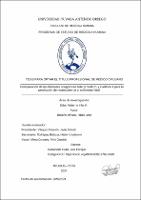| dc.contributor.advisor | Castañeda Cuba, Luis Enrique | |
| dc.contributor.author | Briceño Miñano, Hilder José | |
| dc.creator | Briceño Miñano, Hilder José | |
| dc.date.accessioned | 2024-02-27T15:42:58Z | |
| dc.date.available | 2024-02-27T15:42:58Z | |
| dc.date.issued | 2024 | |
| dc.identifier.uri | https://hdl.handle.net/20.500.12759/23151 | |
| dc.description.abstract | Nuestro estudio tuvo la función de determinar si la fórmula ecográfica
intergrowth-21 es superior para predecir restricción de crecimiento fetal que
hadlock-4 en gestantes atendidas en el servicio de ginecología y obstetricia del
Hospital Regional José Alfredo Mendoza Olavarría.
Materiales y métodos: Se realizó un estudio observacional, analítico de tipo
transversal de pruebas diagnósticas de gestantes atendidas en el Hospital Regional
José Alfredo Mendoza Olavarría durante mayo del 2022 a agosto del 2023. Se
registró en las historias clínicas a las gestantes que se les haya realizado ecografía
con ambas fórmulas ecográficas, para así poder distinguir cual fórmula tiene mayor
predicción para restricción de crecimiento fetal.
Resultados: En este estudio se incluyeron 162 gestantes que recibieron atención
en consulta externa o emergencia del servicio de ginecología y obstetricia del
Hospital Regional José Alfredo Mendoza Olavarría, donde se observó que hadlock-
4 tuvo una sensibilidad de 98.9%, una especificidad de 81.7%, un VPP de 87.4% y
un 98.3% de VPN, mientras que intergrowth-21 tuvo una especificidad de 84.6%,
una especificidad de 97.2%, un VPP de 97.5% y un VPN de 83.1%, tras comparar
ambos resultados observamos que la razón de verosimilitud más alta la obtuvo
intergrowth-21 con 30.038, así mismo la razón de verosimilitud negativa más bajo
la obtuvo hadlock-4 con 0.013, lo que indica que hadlock-4 tiene una alta precisión
diagnóstica.
Conclusiones: La fórmula ecográfica hadlock-4 fue superior en predecir RCIU que
Intergrowth-21 en gestantes atendidas en el Hospital Regional José Alfredo
Mendoza Olavarría II-2. | es_PE |
| dc.description.abstract | Our study had the function of determining whether the intergrowth-21
ultrasound formula is superior in predicting fetal growth restriction than hadlock-4 in
pregnant women treated in the gynecology and obstetrics service of the José
Alfredo Mendoza Olavarria Regional Hospital.
Materials and methods: An observational, analytical, cross-sectional study was
carried out on diagnostic tests of pregnant women treated at the José Alfredo
Mendoza Olavarria Regional Hospital during May 2022 to August 2023. Pregnant
women who had undergone ultrasound with both were recorded in the medical
records. ultrasound formulas, to distinguish which formula has the greatest
prediction for fetal growth restriction.
Results: This study included a total of 162 pregnant women who received care in
an outpatient clinic or emergency clinic of the gynecology and obstetrics service of
the José Alfredo Mendoza Olavarria Regional Hospital, where it was observed that
hadlock-4 had a sensitivity of 98.9%, a specificity of 81.7%, a PPV of 87.4% and a
NPV of 98.3%, while intergrowth-21 had a specificity of 84.6%, a specificity of
97.2%, a PPV of 97.5% and a NPV of 83.1%. After comparing both results, we
observed that the likelihood ratio The highest was obtained by intergrowth-21 with
30.038, likewise the lowest negative likelihood ratio was obtained by hadlock-4 with
0.013, which indicates that hadlock-4 has a high diagnostic precision.
Conclusions: The hadlock-4 ultrasound formula was superior in predicting IUGR
than Intergrowth-21 in pregnant women attended at the José Alfredo Mendoza
Olavarría II-2 Regional Hospital. | es_PE |
| dc.description.uri | Tesis | es_PE |
| dc.format | application/pdf | es_PE |
| dc.language.iso | spa | es_PE |
| dc.publisher | Universidad Privada Antenor Orrego | es_PE |
| dc.relation.ispartofseries | T_MED_3747 | |
| dc.rights | info:eu-repo/semantics/openAccess | es_PE |
| dc.rights.uri | https://creativecommons.org/licenses/by/4.0/ | es_PE |
| dc.subject | Hadlock-4, Intergrowth-21 | es_PE |
| dc.subject | Restricción de Crecimiento Fetal | es_PE |
| dc.title | Comparación de las fórmulas ecográficas Intergrowth 21 y Hadlock 4 para la predicción de restricción de crecimiento fetal | es_PE |
| dc.type | info:eu-repo/semantics/bachelorThesis | es_PE |
| thesis.degree.grantor | Universidad Privada Antenor Orrego. Facultad de Medicina Humana | es_PE |
| thesis.degree.name | Medico Cirujano | es_PE |
| thesis.degree.discipline | Medicina | es_PE |
| dc.subject.ocde | http://purl.org/pe-repo/ocde/ford#3.02.27 | es_PE |
| renati.advisor.orcid | https://orcid.org/0000-0002-2768-2449 | es_PE |
| renati.author.dni | 45096775 | |
| renati.advisor.dni | 18030217 | |
| renati.type | http://purl.org/pe-repo/renati/type#tesis | es_PE |
| renati.level | http://purl.org/pe-repo/renati/level#tituloProfesional | es_PE |
| renati.discipline | 912016 | es_PE |
| renati.juror | Vásquez Alvarado, Javier Ernesto | |
| renati.juror | Rodríguez Barboza, Hector Uladismiro | |
| renati.juror | Mesta Corcuera, Felix Oswaldo | |
| dc.publisher.country | PE | es_PE |




